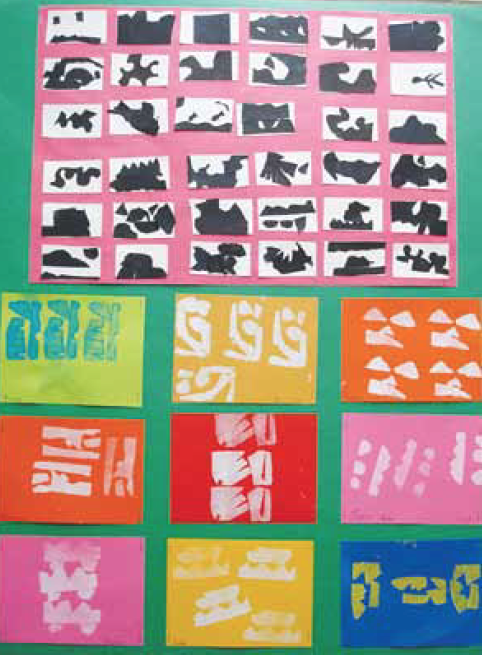Stamp making is a great way to introduce young students to printmaking and yields impressive results while requiring the same skills as collage. Children will explore lines, shapes, colours and patterns while expressing their creativity and practising their cutting skills.
Learning Objectives
Students will understand how ink is different from paint and that brayers are the tool used to roll out ink. They learn that the mark a stamp makes depends on the stamp and is the reverse of the stamp itself. They also learn that only the parts of the stamp that touch the paper will print and that a stamp can be repeated to create a pattern. Students will be able to make a stamp by cutting a variety of lines and shapes out of foam, arranging them in creative ways, and gluing them to a base. They will then use their stamp to create a print that demonstrates experimentation with repetition and pattern.
Materials
- One copy of Swimmy by Lio Lionni
- Water-soluble printing ink
- Trays to hold ink
- A variety of colored papers 8”x10”
- Craft foam sheets •
- Brayers
- Wood bases or cardboard with wine cork glued to it for a handle
- Elmer’s glue
- Smocks or old T-shirts
Vocabulary
Brayer, foam, ink, layer, line (curved, straight, twirly, wavy, wiggly, zig-zag), mix, overlap, shape (circle, diamond, oval, rectangle, square, triangle), spread, stamp, thick.
Prepare for the Activity
1. Purchase or gather the materials listed above.
2. Cover tables with newspaper and set up materials.
3. Introduce children to stamp-making materials by handing out stamps and brayers and inviting children to touch them. As questions such as “What is ink”? and “How is stamping different from painting?” Then, explain that they will be using their own ideas to create a stamp of their own using foam and blocks of wood.
4. Demonstrate how to hold scissors and cut a variety of lines and shapes from foam.
5. Show students how to arrange shapes in different ways on a wood base to create a composition (close together, far apart, touching).
6. Demonstrate how to attach the foam to the wood base with glue: “dip, dip, dip (dipping glue brush in glue), tap, tap, tap (to get excess glue off of a brush).
7. Show students how to ink up and print a stamp and what to do when their stamp runs out of ink. Demonstrate how to create a pattern by repeating the stamp.
8. Display examples of artwork or illustrations from children’s books such as Lio Lionni’s Swimmy. Ask open-ended questions like “Which part of the illustration do you think has been made with a stamp? How can you tell?”
Lead Small Groups
1. Gather three or four students at each table and give each a piece of foam.
2. Invite students to begin by cutting a variety of lines and shapes out of the foam and gluing them onto their wood bases after first experimenting with their arrangement.
3. Once the glue is dry, students can use their foam stamps to make a print of their own. Encourage students to try overlapping their stamps to mix ink colours and repeating their stamps to create patterns on their paper.
4. Students can either work on individual or collaborative prints. If working collaboratively, encourage students to make decisions as a team and support them in celebrating the decisions, selections and placements of their classmates.
5. Once students have made a preliminary print, invite them to make another or share their stamps with each other.
6. Leave completed prints out to dry.
Tips and Hints for Responding to Individual Students
1. Help students with cutting and gluing as needed. Some students may not get past cutting a variety of lines and shapes, and that’s okay. Turn cutting into a game by asking students to pretend that their scissors are an alligator mouth that either takes big or small chomps from the foam.
2. Demonstrate cutting and turning the foam at the same time to get rounded edges. Say “cut and turn, cut and turn.”
3. Help students with stamping as needed, encouraging them to stand for better pressure.
4. Remind students that once the stamp is placed on paper it can’t be moved.
5. Demonstrate what to do when a student’s stamp stops picking up colour. You can explain that the stamp is thirsty and needs another drink of ink.
 Follow Up After the Activity
Follow Up After the Activity
1. Display students’ prints and invite them to describe what they did to create them. Ask students questions such as “How did you make your stamp”? and “Tell us about your print.”
2. Have students title their prints. If their prints tell a story, write down their words and display them with the prints for families and children to look at and discuss.
Involve Families
Make take-away kits for students and ask families to follow up on the activity with them at home by:
- Using the stamp they created in class to print over another artwork or surface.
- Experimenting with stamping a variety of found objects in combination with their stamp.
- Making a new stamp.
ABOUT THE AUTHOR
Agnieszka Chalas
Agnieszka Chalas is currently the Manager of Community Engagement at ArtsSmarts. She holds an MA in Art Education from Concordia University, a BEd from the University of British Columbia, and a BFA from NSCAD University. She has a broad base of experience in art education has published curriculum, resource materials, and articles on topics related to the teaching of art.
This article is from Canadian Teacher Magazine’s Nov/Dec 2012 issue.









